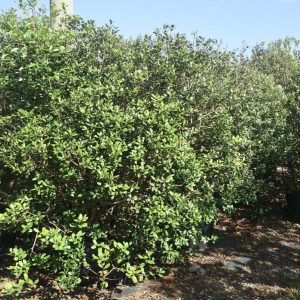Description
Terminalia Catappa Tree Description
Terminalia Catappa (Pacific almond tree, or Indian almond tree) is a ubiquitous tropical tree most often found in coastal areas. As a deciduous tree, it reaches 30 feet (or more) in height with horizontally spreading, slightly droopy branches. In addition, the branches are arranged in tiers giving the crown a “pagoda like” shape. One theory about the tiered branch habit of the tree is to facilitate bat entry for pollination and fruit dispersal. Since, fruit bats carry the fruits away and act as seed dispersers. Also, the branches are prone to breakage. The leaves are large (12 by 6 inches), obovate, glossy green and leathery. Moreover, the leaves change to shades of red, yellow or purple in the cool season before falling. New leaves appear quickly. While the flowers are inconspicuous blossoms, borne in terminal clusters about 6 inches long. They are greenish white in color and aromatic. Furthermore, the fruits are oval in shape, 1 to 3 inches long, and tan colored. Also, the fruit is dry and hard with a thin, edible green to purple flesh, and is rich in tannins. Importantly, the large almond-like seed is edible.
Indian Almond Tree Cultivation and Landscape Usage
Seed is used for propagation. In cultivation, Pacific almond tree is a hardy tree and grows well in any well-drained soil, but is frost sensitive; it benefits from pruning. Indian almond tree is a striking shade tree with its leaves changing color and unusual crown shape. It is a good light shade tree for gardens or parks; it is best grown away from sidewalks and patios as the tannin-rich litter from the leaves and fruits can stain walkways and parked cars.
🌳Other popular and beautiful plants: Terminalia Ivorensis tree.












